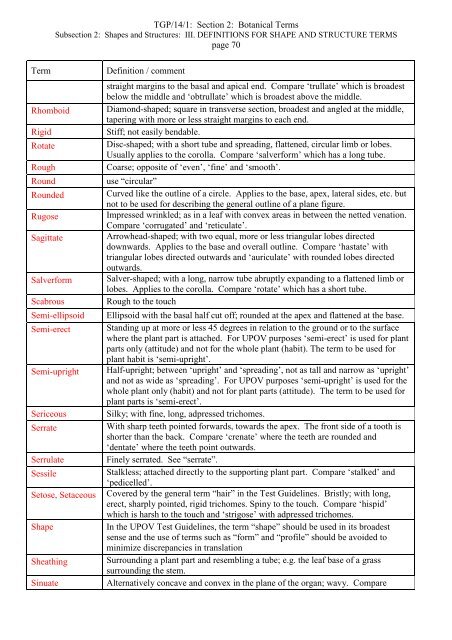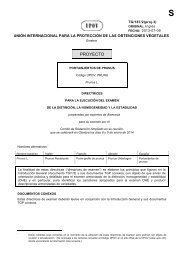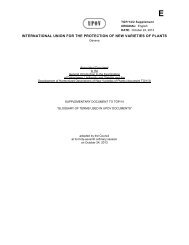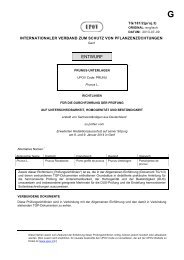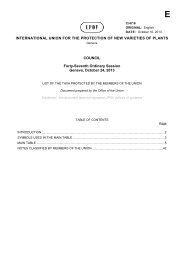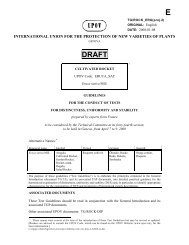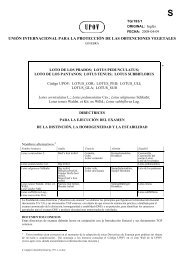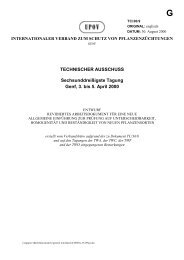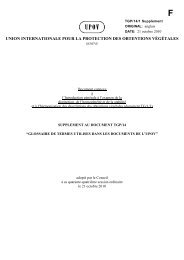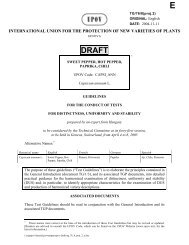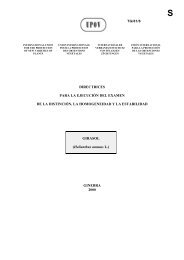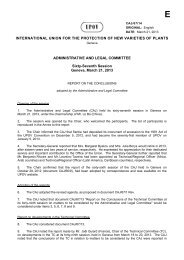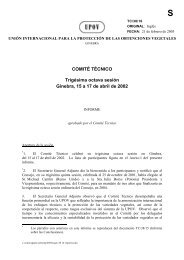E - International Union for the Protection of New Varieties of Plants
E - International Union for the Protection of New Varieties of Plants
E - International Union for the Protection of New Varieties of Plants
You also want an ePaper? Increase the reach of your titles
YUMPU automatically turns print PDFs into web optimized ePapers that Google loves.
TGP/14/1: Section 2: Botanical Terms<br />
Subsection 2: Shapes and Structures: III. DEFINITIONS FOR SHAPE AND STRUCTURE TERMS<br />
page 70<br />
Term<br />
Rhomboid<br />
Rigid<br />
Rotate<br />
Rough<br />
Round<br />
Rounded<br />
Rugose<br />
Sagittate<br />
Salver<strong>for</strong>m<br />
Scabrous<br />
Semi-ellipsoid<br />
Semi-erect<br />
Semi-upright<br />
Sericeous<br />
Serrate<br />
Serrulate<br />
Sessile<br />
Setose, Setaceous<br />
Shape<br />
Sheathing<br />
Sinuate<br />
Definition / comment<br />
straight margins to <strong>the</strong> basal and apical end. Compare ‘trullate’ which is broadest<br />
below <strong>the</strong> middle and ‘obtrullate’ which is broadest above <strong>the</strong> middle.<br />
Diamond-shaped; square in transverse section, broadest and angled at <strong>the</strong> middle,<br />
tapering with more or less straight margins to each end.<br />
Stiff; not easily bendable.<br />
Disc-shaped; with a short tube and spreading, flattened, circular limb or lobes.<br />
Usually applies to <strong>the</strong> corolla. Compare ‘salver<strong>for</strong>m’ which has a long tube.<br />
Coarse; opposite <strong>of</strong> ‘even’, ‘fine’ and ‘smooth’.<br />
use “circular”<br />
Curved like <strong>the</strong> outline <strong>of</strong> a circle. Applies to <strong>the</strong> base, apex, lateral sides, etc. but<br />
not to be used <strong>for</strong> describing <strong>the</strong> general outline <strong>of</strong> a plane figure.<br />
Impressed wrinkled; as in a leaf with convex areas in between <strong>the</strong> netted venation.<br />
Compare ‘corrugated’ and ‘reticulate’.<br />
Arrowhead-shaped; with two equal, more or less triangular lobes directed<br />
downwards. Applies to <strong>the</strong> base and overall outline. Compare ‘hastate’ with<br />
triangular lobes directed outwards and ‘auriculate’ with rounded lobes directed<br />
outwards.<br />
Salver-shaped; with a long, narrow tube abruptly expanding to a flattened limb or<br />
lobes. Applies to <strong>the</strong> corolla. Compare ‘rotate’ which has a short tube.<br />
Rough to <strong>the</strong> touch<br />
Ellipsoid with <strong>the</strong> basal half cut <strong>of</strong>f; rounded at <strong>the</strong> apex and flattened at <strong>the</strong> base.<br />
Standing up at more or less 45 degrees in relation to <strong>the</strong> ground or to <strong>the</strong> surface<br />
where <strong>the</strong> plant part is attached. For UPOV purposes ‘semi-erect’ is used <strong>for</strong> plant<br />
parts only (attitude) and not <strong>for</strong> <strong>the</strong> whole plant (habit). The term to be used <strong>for</strong><br />
plant habit is ‘semi-upright’.<br />
Half-upright; between ‘upright’ and ‘spreading’, not as tall and narrow as ‘upright’<br />
and not as wide as ‘spreading’. For UPOV purposes ‘semi-upright’ is used <strong>for</strong> <strong>the</strong><br />
whole plant only (habit) and not <strong>for</strong> plant parts (attitude). The term to be used <strong>for</strong><br />
plant parts is ‘semi-erect’.<br />
Silky; with fine, long, adpressed trichomes.<br />
With sharp teeth pointed <strong>for</strong>wards, towards <strong>the</strong> apex. The front side <strong>of</strong> a tooth is<br />
shorter than <strong>the</strong> back. Compare ‘crenate’ where <strong>the</strong> teeth are rounded and<br />
‘dentate’ where <strong>the</strong> teeth point outwards.<br />
Finely serrated. See “serrate”.<br />
Stalkless; attached directly to <strong>the</strong> supporting plant part. Compare ‘stalked’ and<br />
‘pedicelled’.<br />
Covered by <strong>the</strong> general term “hair” in <strong>the</strong> Test Guidelines. Bristly; with long,<br />
erect, sharply pointed, rigid trichomes. Spiny to <strong>the</strong> touch. Compare ‘hispid’<br />
which is harsh to <strong>the</strong> touch and ‘strigose’ with adpressed trichomes.<br />
In <strong>the</strong> UPOV Test Guidelines, <strong>the</strong> term “shape” should be used in its broadest<br />
sense and <strong>the</strong> use <strong>of</strong> terms such as “<strong>for</strong>m” and “pr<strong>of</strong>ile” should be avoided to<br />
minimize discrepancies in translation<br />
Surrounding a plant part and resembling a tube; e.g. <strong>the</strong> leaf base <strong>of</strong> a grass<br />
surrounding <strong>the</strong> stem.<br />
Alternatively concave and convex in <strong>the</strong> plane <strong>of</strong> <strong>the</strong> organ; wavy. Compare


